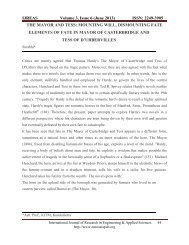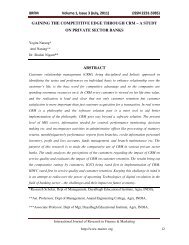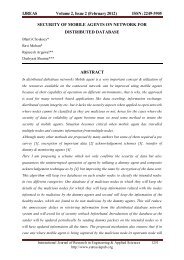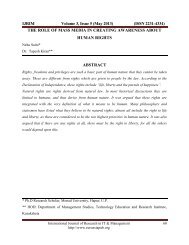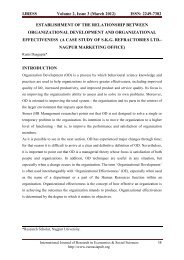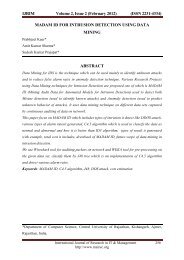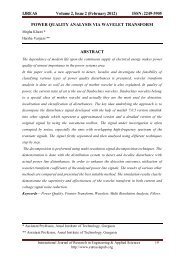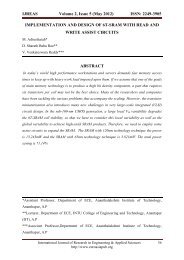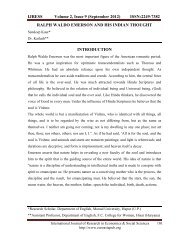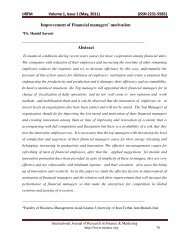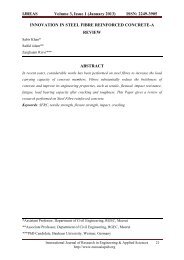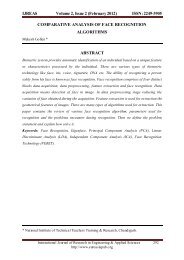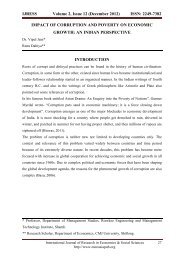visualization of flow behavior and its effected ... - Euroasiapub.org
visualization of flow behavior and its effected ... - Euroasiapub.org
visualization of flow behavior and its effected ... - Euroasiapub.org
You also want an ePaper? Increase the reach of your titles
YUMPU automatically turns print PDFs into web optimized ePapers that Google loves.
IJREAS Volume 2, Issue 5 (May 2012) ISSN: 2249-3905VISUALIZATION OF FLOW BEHAVIOR AND ITS EFFECTEDCONTOUR IN SUDDEN CONTRACTION, SUDDEN ENLARGEMENTAND SUDDEN ELBOW BY ANSYSNavtej Singh*Suneev Anil Bansal**N.K Batra***ABSTRACTThis paper describes an analytical approach to describe the areas where Pipes (used for <strong>flow</strong>)are mostly susceptible to damage. Their basic contours are discussed to know pressure values<strong>and</strong> velocity values at various sections <strong>of</strong> the pipe. ANSYS 13 s<strong>of</strong>tware was used to plot thecharacteristics <strong>of</strong> the <strong>flow</strong>. Numerical simulations <strong>of</strong> the <strong>flow</strong> past pipes <strong>of</strong> various geometrieswere performed. Comparisons were made with the experimental <strong>and</strong> computational resultspresented in various studies previously. Paper tries to visualize the <strong>flow</strong> <strong>behavior</strong> in variousgeometric conditions <strong>of</strong> a pipe.*Lecturer, Department <strong>of</strong> Mechanical Engineering, MM Engineering College, Mullana,Amabala**Lecturer, Department <strong>of</strong> Mechanical Enginering, Q I E T, Mohali***Pr<strong>of</strong>essor & HOD, Department <strong>of</strong> Mechanical Engineering, MM Engineering College,Mullana, AmabalaInternational Journal <strong>of</strong> Research in Engineering & Applied Sciences 89http://www.euroasiapub.<strong>org</strong>
IJREAS Volume 2, Issue 5 (May 2012) ISSN: 2249-39051. INTRODUCTIONPipes are the most efficient media for transporting fluid from one place to another. Theefficiency <strong>of</strong> the system to minimize the losses in a network is as important as saving moneythese days. The researchers all over the world are working hard to find a solution to minimizethese head losses (energy), total length <strong>of</strong> the network <strong>and</strong> pipe diameters. Lahiouel Y et al[1]. When a viscous fluid <strong>flow</strong>s through a pipe, a part <strong>of</strong> <strong>its</strong> energy is spent in the maintenance<strong>of</strong> the <strong>flow</strong>. This energy is converted into thermal energy because <strong>of</strong> <strong>its</strong> internal friction <strong>and</strong>turbulence. This leads to the expression <strong>of</strong> the energy loss in terms <strong>of</strong> the fluid height knownas the head loss. These losses are classified into major losses or linear head present throughoutthe length <strong>of</strong> the pipe <strong>and</strong> minor losses or singular head occurring due to minor appurtenance<strong>and</strong> accessories present in a pipe network. These appurtenances encountered by the fluid <strong>flow</strong>are sudden or gradual changes <strong>of</strong> the boundaries resulting in a change in magnitude, directionor distribution <strong>of</strong> the velocity <strong>of</strong> the <strong>flow</strong>. If pipes have many minor appurtenances but <strong>its</strong>length is small then <strong>its</strong> total minor head losses can be greater than frictional head loss. In pipesused for petroleum <strong>and</strong> water distribution system having considerable length, the terms- majorhead loss <strong>and</strong> minor head loss can be used without confusion. Lahiouel Y et al [2]. Time totime many researchers worked in order to achieve a general <strong>and</strong> precise formulation <strong>of</strong> thediverse type <strong>of</strong> head losses. Weisbach, 1855 [3] was the first one to give the concept <strong>of</strong>relation for head loss. Darcy[4] <strong>and</strong> Weisbach formulated equation- Darcy-Weisbach formulato measure accurate pipe friction loss. It is one <strong>of</strong> the most accurate formulas for measuringthe pipe friction loss but is difficult to calculate <strong>and</strong> use than the other friction formulas. It hasnow become a st<strong>and</strong>ard equation for hydraulic engineers in practice. However, until then theestablishment <strong>of</strong> the friction was still unresolved. Nikuradse [5] performed many experimentsusing smooth <strong>and</strong> artificially roughened pipes <strong>and</strong> drew a diagram, also known as Stantondiagram or Stanton-Pannel diagram. Colebrook [6] found that results <strong>of</strong> Nikuradse do notmatch with actual pipes. It was possible to use results for commercial pipes by introducing theconcept <strong>of</strong> equivalent surface roughness. Colebrook then derived a relation known asColebrook-white equation for finding friction factor in turbulent <strong>flow</strong>. Pr<strong>and</strong>tl [7] found therelation expressing friction coefficient as a function <strong>of</strong> (e/D). It is now widely known asKarman-Pr<strong>and</strong>tl equation. Rouse [8] plotted friction coefficient (1/ ) against the Karmannumber represented by:K=R e = D 3/2International Journal <strong>of</strong> Research in Engineering & Applied Sciences 90http://www.euroasiapub.<strong>org</strong>
IJREAS Volume 2, Issue 5 (May 2012) ISSN: 2249-3905He produced the necessary curves for the Colebrook transition zone. In 1944, L.F Moddyplotted charts using Colebrook-white equation known as moody charts or friction factor chartbased on the roughness <strong>of</strong> the pipe against the Reynolds’s number <strong>of</strong> the pipe. For <strong>flow</strong>between 2000
IJREAS Volume 2, Issue 5 (May 2012) ISSN: 2249-3905on a coupled solver for solving the differential equations using the fully implicitDiscretisation method <strong>and</strong> treating the hydrodynamic equations as one single system. Toreduce the number <strong>of</strong> iterations required for convergence, a false-time stepping method isimposed which guides the approximate solutions in a physically based manner to a steadystatesolution. Buoyancy is modeled using the Boussines approximation in which the forcesare modeled as source terms in the momentum equations. Various models exist in CFX-5code for modeling turbulent <strong>flow</strong>. Two-equation models based on the eddy-viscosity conceptinclude the k-ε (Launder <strong>and</strong> Spalding, 1974), k-ω (Wilcox, 1998) <strong>and</strong> Shear StressTransport (SST) k-ω based (Menter, 1994) models. Compared to the commonly used k-εturbulence model, the k-ω model implies a new formulation for the near wall treatmentwhich provides an automatic switch from a wall-function to a low-Reynolds numberformulation based on the near-wall grid spacing. This makes it more accurate <strong>and</strong> morerobust. The turbulence viscosity is assumed to be linked to the turbulence kinetic energy(kequation) <strong>and</strong> turbulent frequency (ω-equation) instead <strong>of</strong> the turbulence dissipation rate(ε-equation in the k-ε model). To overcome the sensitivity <strong>of</strong> the k-ω model to free streamconditions, the SST model was developed. It blends the k-ω model near the surface with thek-ε model in the outer region. In contrast, Reynolds Stress Turbulence models such as thest<strong>and</strong>ard Launder-Reece-Rodi Isotropic Production (LRR-IP) model (Launder et al, 1975)<strong>and</strong> Second Moment Closure-ω (SMC-ω) model (Wilcox, 1998), do not use the eddyviscosityhypothesis, but solve transport equations for all components <strong>of</strong> the Reynoldsstresses. This makes Reynolds Stress models more suited to complex <strong>flow</strong>s. However,practice shows that they are <strong>of</strong>ten not superior to two-equation models because convergencedifficulties <strong>of</strong>ten occur. The LRR-IP model is based on the k-ε model, whereas the SMC- ωis based on the k-ω model with the advantages already explained Zitzmann, T et al [12].Now, the default fluid in CFX is air, but we want to define fluid as water. In the Create/editFluent database, water liquid is selected. In cell zone condition, default selection is solid, thisis changed into fluid <strong>and</strong> water liquid is selected. In boundary condition inlet velocitymagnitude is set along with Turbulence intensity <strong>and</strong> Hydraulic diameter. Beforeinitialization from Residual monitors, plot <strong>and</strong> print to console are selected. Then, calculationwith 500 number iteration <strong>and</strong> change reporting interval to 10 is run <strong>and</strong> the solution iscalculated. These results are now confirmed by doing experiments in the lab. Water <strong>flow</strong>ingfrom elbow, sudden enlargement <strong>and</strong> contraction is collected in a tank with 0.16 m 2 area.Diameter <strong>of</strong> the small <strong>and</strong> large pipe is 0.025m <strong>and</strong> 0.05m.International Journal <strong>of</strong> Research in Engineering & Applied Sciences 93http://www.euroasiapub.<strong>org</strong>
IJREAS Volume 2, Issue 5 (May 2012) ISSN: 2249-39054. RESULTS AND ANALYSISThree set <strong>of</strong> conditions are discussed in this network <strong>of</strong> pipes. All three conditions viz suddenenlargement, sudden contraction & elbow frequently appear in the pipe network. Variouschanges in parameters <strong>of</strong> the pipe network are discussed. The numerical values thus achievedare shown in tables in respective cases.4.1 Flow Behavior in Sudden Enlargement:In sudden enlargement, diameter <strong>of</strong> 0.0125m is enlarged to 0.025m. Various velocity <strong>and</strong>pressure charts are drawn <strong>and</strong> shown in table1, figure 2 & 3.Table 1 : Sudden EnlargementParameterValueLarge Diameter (outlet)0.025 mSmall Diameter (inlet)0.0125 mLength <strong>of</strong> small dia. pipe 0.1mLength <strong>of</strong> large dia. Pipe 0.1mInlet Velocity1.44 m/sMin Pressure-3.78e+002Max. Pressure1.35ee+00Figure 2: Sudden Enlargement (Pressure Behavior)International Journal <strong>of</strong> Research in Engineering & Applied Sciences 94http://www.euroasiapub.<strong>org</strong>
IJREAS Volume 2, Issue 5 (May 2012) ISSN: 2249-3905Figure 3: Sudden Enlargement (Velocity Behavior)4.2 Flow Behavior in Sudden Contraction:In sudden contraction, diameter <strong>of</strong> 0.025m is decreased to 0.0125m. Various velocity <strong>and</strong>pressure charts are drawn <strong>and</strong> shown in table 2, figure 4& 5.Table 2 : Sudden ContractionParameterValueLarge Diameter(inlet) 0.025 mSmall Diameter(outlet) 0.0125 mLength <strong>of</strong> small dia. pipe 0.1mLength <strong>of</strong> large dia. Pipe 0.1mInlet Velocity1.44 m/sMin Pressure-9.4e+003Max. Pressure2.7e+004International Journal <strong>of</strong> Research in Engineering & Applied Sciences 95http://www.euroasiapub.<strong>org</strong>
IJREAS Volume 2, Issue 5 (May 2012) ISSN: 2249-3905Figure 4 : Sudden Contraction (Pressure Behavior)Figure 5: Sudden Contraction (Velocity Behavior)4.3 Flow Behavior in Sudden Bend (Elbow):In elbow, pipe diameter <strong>of</strong> 0.025m is taken. Radius <strong>of</strong> pipe bend is taken as 0.02625m.Various velocity <strong>and</strong> pressure charts are drawn <strong>and</strong> shown in table 3,figure 6 & 7.Table 3 : Sudden Bend(Elbow)ParameterValueLength L1 0.1mLength L2 0.1mRadius at corner 0.0525mRadius <strong>of</strong> pipe 0.02625mInlet Velocity 3m/sMin Pressure -5.8e+003Max. Pressure 4.8e+003International Journal <strong>of</strong> Research in Engineering & Applied Sciences 96http://www.euroasiapub.<strong>org</strong>
IJREAS Volume 2, Issue 5 (May 2012) ISSN: 2249-3905Figure 6 : Sudden Bend (Pressure Behavior)5. DISCUSSION & CONCLUSIONFigure 7: Sudden Bend (Velocity Behavior)From the above analysis, it is observed that the <strong>flow</strong> is severely disrupted if there are contourchanges occurring in the downstream <strong>flow</strong> in the pipe. Sudden enlargement creates moresevere formation <strong>of</strong> <strong>flow</strong> eddies than sudden contraction. Also, the losses are more at thepoint where the enlargement in the pipe begins.In the sudden contraction, vane contracta’s are formed at the point <strong>of</strong> contraction <strong>and</strong> thispoint is the most susceptible point for pipe damage. In elbow, the outer corner at the bend ismore susceptible to damage because the pressure is maximum at this contour. So, to increasethe life <strong>of</strong> the pipe in cases <strong>of</strong> sudden contraction & enlargement, the pipes must be designedin view <strong>of</strong> the above observations making the corners more round so as to minimize thelosses in the pipes. However, at the elbows, outer regions must be made thicker to increasestrength <strong>of</strong> the bend to be able to bear the increased pressure changes at this contour.International Journal <strong>of</strong> Research in Engineering & Applied Sciences 97http://www.euroasiapub.<strong>org</strong>
IJREAS Volume 2, Issue 5 (May 2012) ISSN: 2249-3905To conclude, this examination results indicate that ANSYS can be used with high degree <strong>of</strong>accuracy to visualize the minor or singular head losses due to minor appurtenances <strong>and</strong>accessories present in a pipe network.6. REFERENCES[1] Lahiouel Y., Haddad A., Khezzar L., Chaoui K., Kondratas A.,“Development <strong>of</strong> method<strong>of</strong> routing fluid distribution networks”, J. Mechanica, Vol. 43, N° 4, (2003), pp. 27-34.[2] Lahiouel Y., Haddad A., Chaoui K., “Evaluation <strong>of</strong> head losses in fluid Transportationnetworks Sciences & Technologies B – N°23, juin (2005), pp. 89-94[3] Weisbach J.“Die Experimental Hydraulik”, Freiberg, Germany: Engelhardt, (1855).[4] Darcy Weisbach Formula http://www.pipe<strong>flow</strong>.com/pipe-pressure-drop-calculations/pipe-friction-loss ( 12/15/2011)[5] Nikuradse J., 1933,“Strmungsgesetze in Rauben Rohren”, pp 361, Verein DeutsherIngenieure, Forschungsheft, (1933).[6] Colebrook C.F.,“Turbulent Flow in Pipes with Particular reference to the TransitionRegion between the Smooth <strong>and</strong> Rough Pipe Laws”, J. Inst. <strong>of</strong> Civil Engrs.N° 11,(1939),pp.133-156.[7] Bhave, P.R.,“Analysis <strong>of</strong> <strong>flow</strong> in water distribution networks”, pp.25-68 TechnomicPub. Co., Inc., USA, (1991).[8] Rouse H., “Evaluation <strong>of</strong> Boundary Rough Proc.2 nd Hydraul. Conf., Bulletin N° 27,Univ. o f Lowa, Lowa City, (1943).[9] Moody L.F., “Friction Factors for Pipe Flow”, Trans. American Society <strong>of</strong>Mechanical. Engineers., No. 66, (1944), pp. 671-684.[10] Hazen-Williams Formula http://www.pipe<strong>flow</strong>.com/pipe-pressure-drop-calculations/pipe-friction-loss ( 12/15/2011)[11] Ansys ,Inc. http://http://www.idac.co.uk/products/downloads/ Meshing.pdf[12] Tobias Zitzmann1, Malcolm Cook2, Peter Pfrommer1,Simon Rees2, LjiljanaMarjanovic2, “Simulation Of Steady-State Natural Convection Using CFD” NinthInternational IBPSA Conference Montréal, Canada[13] JONAS BREDBERG http://www.tfd.chalmers.se/~lada/postscript_files/jonas_report_lowre.pdfInternational Journal <strong>of</strong> Research in Engineering & Applied Sciences 98http://www.euroasiapub.<strong>org</strong>



